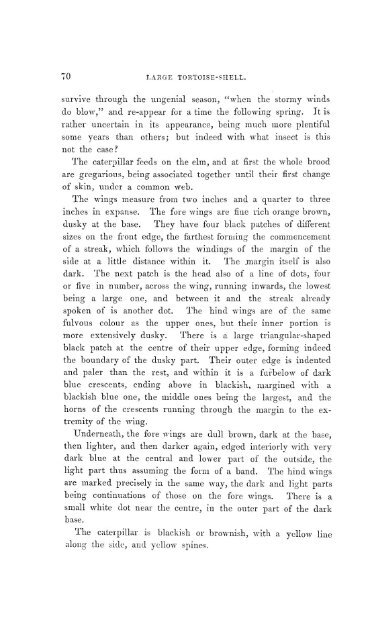S-1141001_COMPLETO.pdf
S-1141001_COMPLETO.pdf
S-1141001_COMPLETO.pdf
You also want an ePaper? Increase the reach of your titles
YUMPU automatically turns print PDFs into web optimized ePapers that Google loves.
70 LARGE TORTOISE-SHELL.<br />
survive through the ungenial season, "when the stormy winds<br />
do blow," and re-appear for a time the following spring. It is<br />
rather uncertain in its appearance, being much more plentiful<br />
some years than others; but indeed with what insect is this<br />
not the case?<br />
The caterpillar feeds on the elm, and at first the whole brood<br />
are gregarious, being associated together until their first change<br />
of skin, under a common web.<br />
The wings measure from two inches and a quarter to three<br />
inches in expanse. The fore Avings are fine rich orange brown,<br />
dusky at the base. They have four black patches of different<br />
sizes on the front edge, the farthest forming the commencement<br />
of a streak, which follows the windings of the margin of the<br />
side at a little distance within it. The jnargin itself is also<br />
dark. The next patch is the head also of a line of dots, four<br />
or five in number, across the wing, running inwards, the lowest<br />
being a large one, and between it and the streak already<br />
spoken of is another dot. The hind Avings are of the same<br />
fulvous colour as the upper ones, but their inner portion is<br />
more extensively dusky. There is a large triangular-shaped<br />
black patch at the centre of their upper edge, forming indeed<br />
the boundary of the dusky part. Their outer edge is indented<br />
and paler than the rest, and within it is a furbelow of dark<br />
blue crescents, ending above in blackish, margined with a<br />
blackish blue one, the middle ones being the largest, and the<br />
horns of the crescents running through the margin to the ex<br />
tremity of the wing.<br />
Underneath, the fore Avings are dull broAvn, dark at the base,<br />
then lighter, and then darker again, edged interiorly Avith very<br />
dark blue at the central and loAver part of the outside, the<br />
light part thus assuming the form of a band. The hind wings<br />
are marked precisely in the same way, the dark and light parts<br />
being continuations of those on the fore wings. There is a<br />
small white dot near the centre, in the outer part of the dark<br />
base.<br />
The caterpillar is blackish or brownish, with a yellow line<br />
along the side, and yellow spines.

















